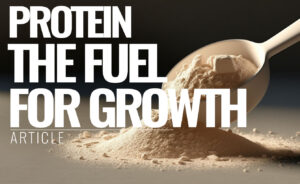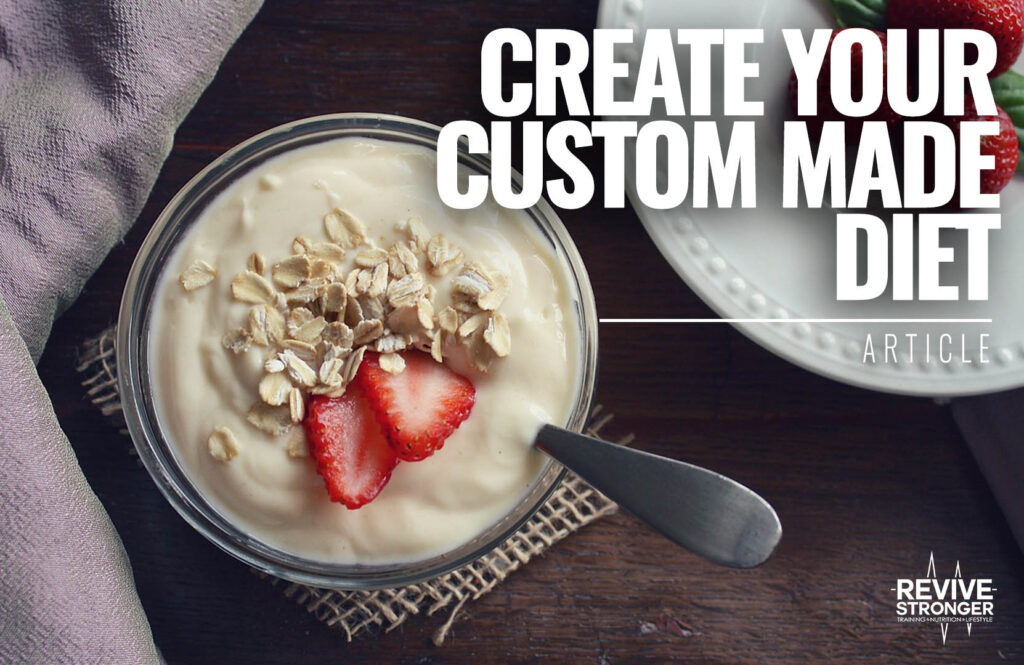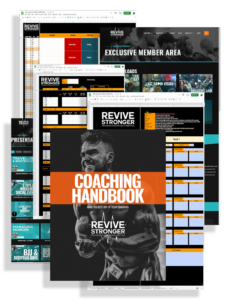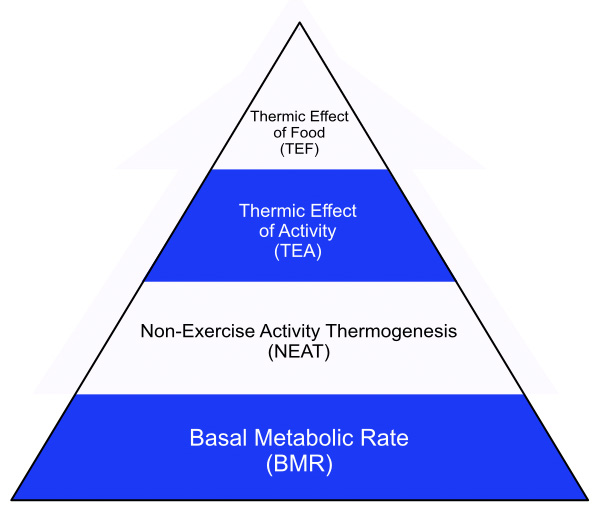
Revive Stronger
Your Tailor-Made Diet

The purpose of this article is to give you everything you need to start your diet and move towards your goals.
Whether it be fat loss, muscle gain or maintenance, you will know how much to eat and where to get it.
You will also be educated to why you are eating certain amounts of different nutrients.
^ That is incredibly important because you will take an informed approach to dieting, not just following some plan laid out.
The information here is the stuff everyone should know, no matter if you’re an elite athlete or an office worker. I believe that we should all have a basic understanding of nutrition, so we can be empowered to create a tailor-made diet to change our body in positive ways if so required.
What we eat is composed of nutrients, these come in two forms; macro-nutrients and micro-nutrients. The macro-nutrients are abundant in our diet, whereas the micronutrients are consumed in smaller quantities. They’re all important for our health, and play distinct roles.
Once we have consumed a food it gets broken down and absorbed by our bodies, we know what we ate, but all the body sees is the nutrient absorbed. For example, if you eat an apple the carbohydrates in that apple get broken down into glucose to be used by our body, the same thing happens with white bread, again glucose is derived and absorbed by our body, but our body doesn’t recognise the difference, it just sees glucose.
However, although most carbohydrate-rich foods get broken down into the same glucose molecules, protein foods become amino acids, and fats become fatty acids, it doesn’t mean that the type of food doesn’t matter. For example, if we look at the apple vs. the white bread, the apple contains more fibre than the bread, which slows digestion down and keeps us fuller, plus the apple arguably contains more vitamins and minerals that are essential for our body.
So apples are better? Not entirely, it isn’t as simple as that. You see macro-nutrients provide our bodies with calories, and calories are the masters of our bodies fate. Consume too many of them and we gain weight, consume too little and we lose it. I will cover that in detail later. So if your overall diet had you consuming the right amount of calories to maintain your weight, and you ate lots of fruit and veggies and had an appropriate mix of protein, fat and carbohydrate, and maintaining weight was your goal, then both the white bread an apple could be considered healthy in the context of that person’s diet.
You see it isn’t as black and white as foods being ‘good’ or ‘bad’, you need to take a wider view, and consider a person’s entire diet, and whether it provides them with the right macro, micro-nutrition and total calories. So you can see there is a need to know that foods contain nutrients, the role these nutrients play in our bodies and how much of these we need and how our nutritional choices can affect our bodies. Once we have knowledge of all that, we can have the power to manipulate our bodies at will!
So let’s look at what food provides our bodies; Calories, Macro & Micronutrients…
Table of Contents
Calorie Facts
- A unit of measure; the amount of heat needed to raise 1g of water by 1 degree C.
- Researchers burn foods to see how much heat is given off, this gives a calorie content.
- Each person burns a certain number of calories per day, this is made up of their basal metabolic rate (BMR- energy used to stay alive), activity level (exercise), non-exercise activity expenditure (NEAT- fidgeting etc.), non-exercise activity physical activity (NEPA- walking the dog, cleaning the car etc.) and to a lesser degree the thermic effect of food (TEF- energy lost in digestion). Check out the Metabolic Pyramid from Get Big, Stay Lean below.
- Energy expenditure is measured by the rate of oxygen consumption by our body or heat output.
- The take-home point is that everyone has a different caloric burn, there is no one size fits all. So the common 2000 calories for a woman and 2500 calories for a man, is not helpful as it isn’t at all suited to the individual.
Practical Application
So now you know what calories are, and that we all have different calorie needs, how might you go about assessing your individual requirements? I’m gonna help you out.
There are a number of different calculations out there including; The Katch-McArdle Equation, Owen Equation, Mifflin-St Jeor Equation, Harris-Benedict Equation, Aragon Equation, WHO Equation and The Cunningham Formula. They normally land within around 200-400 calories of one another, and for simplicities sake because every calculation is an estimate I like to keep things simple by using the below.
Body Weight in pounds x 13 to 16
- Factors putting you at the higher range: male, high training volume, active job and low bodyfat % (sub 15% for males, sub 25% for females).
- Factors putting you at the lower range: female, low training volume, sedentary and high bodyfat % (over 15% for males, over 25% for females).
This will require some manipulation to ensure you’re getting what you need. It also is very generic, remember that pesky principle of individuality, we are all unique and have different biochemistry, so we cannot expect simple calculations to work perfectly. But they give us a good starting point, and later I will give you an example to make things clearer.
The Laws of Thermodynamics
We do not produce energy in the body, energy is transferred from the food we eat, to us. The Laws of Thermodynamics describe some of the rules by which the physical world is organised and tell us that energy is never created and never destroyed, but transferred. So we convert the energy that is stored in food into usable energy for our bodies to use. So that apple earlier contains energy, we eat it and it’s energy gets transferred, we cannot make energy out of thin air, it comes from our food.
We eat food, digest it, absorb it, store it, transfer it and use it, this cycle is never-ending. When we are talking about humans our energy input is calories. when our expenditure is greater than our intake, weight is lost, this is called a calorie deficit. And if intake is greater than expenditure, weight is gained, this is called a calorie surplus. So when there is an energy imbalance, we do not maintain our current state.
There are two sides to this energy balance, the food we take in, and our metabolic rate, which as seen above is made up of multiple things. Thus we can purposefully create an energy imbalance to lose and gain weight. Imagine on the scale above, on one side is our diet and on the other is our total energy expenditure, currently, they are in balance, but if one outweighs the other the scale will shift.
For Fat Loss
- Take your maintenance calculation and subtract by 15 to 25%.
- I would start small unless you have a very good reason for losing weight fast.
- Aim for 0.5 to 1% of total bodyweight lost per week.
- It might be slightly higher than 1% in the first few weeks, this is OK, it’s likely water and glycogen loss, however if it is continually higher than 1% bump your calorie intake up.
For Muscle Gain
- Take your maintenance calculation and add 200 to 400 calories.
- The longer you have been training the nearer the low end you want to go.
- Aim for 1 to 4 pounds of weight added per month.
- The longer you have been training the nearer the low end you want to go.
Always keep in mind that these recommendations are best guesses, our bodies are massively complex and don’t fit simple equations. However, as said previously these do give us a nice starting point. If you are completely lost you might want to take a look at my coaching services.
Macronutrient Facts
Calories are our bodies energy source and they are derived from our macronutrients; protein, fat, carbohydrate and alcohol.
Protein
- 4 calories per gram.
- Essential for growth and ongoing repair, nitrogen balance, enzymes that catalyse innumerable chemical reactions, cell signalling and signal transaction.
- The most satiating of all macronutrients and with the highest TEF, which are two great reasons for having a high protein diet while dieting.
Fat
- 9 calories per gram.
- Needed for hormone production, cholesterol and cell membrane formation, protect organs, supply vitamins (A,D,E,K) and gives the main energy source for the body at rest.
- There are many types of fat including, saturated, poly-unsaturated, mono-unsaturated, trans-fats and omega fatty acids.
- Essential Fatty Acids (EFA’s) are by name essential for the body, these include Omega 3 and 6. Generally, people lack Omega 3, which is found predominantly in fatty fish.
Carbs
- 4 calories per gram.
- There are many different forms such as lactose, fructose, glucose etc. but that is beyond the scope of this article.
- Non-Essential but it is the bodies preferred energy source, especially during stress and exercise. When glycogen levels get low in the body, cortisol levels rise. They’re essential to perform at your best during intense exercise bouts.
- Contains fibre which cannot be digested and thus helps to increase the bulk of intestinal contents, aiding digestion, keeping us fuller. Furthermore, fibre provides energy for the intestinal absorptive cells, also they may absorb bile salts and potential carcinogens in the diet.
- Fibre is great, but you can have too much, my advice is 25g as a minimum and in general aim for 10 to 20% of your total carbohydrate intake with 70g as an upper cap.
- Why carbs aren’t addictive, toxic & can help promote health.
Alcohol
- 7 calories per gram.
- Cannot be stored by the body and is essentially a toxin.
The above are found in foods/drinks to varying degrees and come together to give you an overall calorie intake. All as you can see have their own specific roles for our body to remain healthy (bar alcohol), long-term restriction of any one macronutrient can lead to a decrease of metabolic function.
Practical Application
- Protein – 0.8 to 1.3g per pound of bodyweight consumed.
- Edge to the higher end: the leaner & older you are & if you’re in a caloric deficit.
- Fat – Between 0.25 to 0.6g per pound of bodyweight or 15 to 30% of total calories.
- Edge to the higher end: the less active you are, the older you are & higher % body fat.
- Carbs – Generally carbohydrates will make up the remainder of your calorie intake. With 0.5g per lb being the minimum.
- Alcohol – I am not going to tell you this is in any way needed for our bodies, sorry, but you can consume it in moderation and maintain good health. I recommend you decrease your fat and carb intake to allow for the occasional alcoholic beverage if desired.
You can see there are some quite broad recommendations there, and that is because there is no one ‘best’ way to set these up, however, land within these ranges and you’re doing well. The biggest guiding influence will be your personal preference, and I really want you to stick to your preferences. So if you like high protein, then go towards the higher end of the scale, if you love your fats then bump em up. As long as you are within your ranges and they bring you to your desired calorie intake, you’re A-OK.
“Do not discount eating to preferences, it’ll keep you consistent, and that’ll bring results.”
Micronutrient Facts
Vitamins
- Organic compounds obtained from food, required in small amounts for maintenance of normal metabolic function.
- They are a dietary essential and cannot be synthesised by the body (Vitamin D and Niacin can be synthesised but not sufficiently so are included).
Minerals
- Inorganic and found in foods, most who eat a mixed diet receive adequate amounts.
- When intake is insufficient a deficiency may develop but when taken in excess may become toxic.
- Provide a variety of roles including; maintenance of muscle contractility, response to hormones and neurotransmitters, metabolic regulation, maintenance of healthy bones and teeth, protection against free radicals, efficient reactions and hormone synthesis, oxygen transport and enzyme function.
Phytochemical’s
- Contain no energy and are found in plants and can help protect against disease.
Water
- Water is needed for us to live, without it we would die.
- Just a 2% decrease in body weight from water can impact our performance, so we want to keep well hydrated, especially around workouts.
Practical Application
- Eat a varied diet, which means lots of colour and types of protein, fats and carbohydrates.
- Consume a minimum of 1 serving of fruit and vegetable per 1000 calories.
- Drink to your own personal thirst, if that isn’t specific enough then go for 1 litre per 1000 calories consumed or ensure 5 of your daily urinations are clear.
- Try and get 20 to 30 minutes of sun exposure a day (don’t be reckless, use sun-screen if necessary).
Case Study
To make the above really clear I am going to put it into a case study. Take Rob, he is a 25-year-old male, weighing in at 180lbs, and looking to gain some lean muscle mass. First, we look to estimate his calorie requirements, he trains 5 times a week and has an office job, so we shoot for the middle ground and go with 15 as are multiplier:
15 x 180 (bodyweight) = 2700
So we can see around 2700 calories would maintain his current weight. Now Rob has been lifting for about 2 years, and therefore has got most of his newbie gains. He can therefore look to add around 2lbs a month, so we add in 300 calories:
2700 (maintenance) + 300 = 3000 calories
So Rob has estimated he wants around 3000 calories to gain at his desired rate. Next is splitting this up between the macronutrients, first lets go with protein. As Rob is pretty young and not in a calorie deficit we can safely shoot towards the lower end of the recommendation:
180 (bodyweight) X 0.8 = 144g Protein
If Rob had a desire to eat more than that, he could use a higher multiplier. Now we move onto fat, as Rob is active and young he wants to make the most out of his performance so shoots for a slighter lower fat range:
3000 calories X 0.2 (20%) = 600 calories
As we know fat contains 9 calories per gram, we can divide 600 by 9:
600/9 to give 67g of fat
Last but not least is carbohydrates, so we have 600 calories coming from fat, as we know protein contains 4 calories per gram we can find out what is left for carbs:
144 (protein) X 4 = 576 calories
576 + 600 = 1176 calories
So far we have used 1176 of Rob’s total calorie intake, we can now use this to determine his carb intake, remember carbs have 4 calories per gram, just like protein:
3000 – 1176 = 1824
1824 / 4 = 456g of Carbs
And there we have it, by using the steps above we have come to produce Rob’s muscle building diet:
Calories: 3000 | 144g Protein | 67g Fat | 456g Carbs
Remember this is just an estimate, and thus it will likely need adjusting with real world changes. I would also note that those are some pretty ugly numbers, I would always recommend giving yourself some ranges to make life more livable. For example with Rob I could go with:
Calories: 2900 – 3100 | 140 to 160g Protein | 65 to 75g Fat | 450 to 470g Carbs
Ranges are just one of the Pillars of Flexibility I touch on in Get Big, Stay Lean, there are many other ways you can make a diet work for you. So Rob would go forward with this estimated guideline and adjust as necessary, for example, say he on average consumed 2950 calories for two weeks and didn’t see a difference on the scale, he maintained. He could then increase his intake by say 100 calories, adding in some carbohydrates and fat, and then monitor whether that was enough to bring about his goals.
Putting it all Together
So now you have learnt the nutritional basics, you now know that food provides nutrients and those nutrients have distinct roles for our bodies. You also now know that everyone requires different amounts of each, and this is in relation to their total energy burn and goals. Below is a summary of the practical application to make things simple when trying to create your Taylor-Made diet.
- Calories: 13 to 16 x bodyweight in pounds (-15 to 25% for fat loss, +200 to 400 for muscle gain).
- Protein: 0.8 to 1.3 grams per pound of bodyweight.
- Fat: 15 to 30% or 0.25 to 0.6 grams per pound of bodyweight.
- Carbs: make up the left over calories (0.5g per lb as a minimum)
- Micros: 25g of fibre minimum or 10 to 20% of total carb intake, 2 serving fruits/vege per 1000kcal minimum, drink to thirst and eat a varied diet.
You also now know that the body doesn’t see food, it only sees nutrition. So as long as you get sufficient macro and micro nutrition, everything you eat can be considered healthy and productive for your goals. By that I mean you no longer have to be worried about eating white bread, or whatever the demonised food may be: so long as you nail your micro and macro nutrition, you can eat to your preferences
This is something called Flexible Dieting, which I am sure you will hear me talk about again, and it is the method of dieting used in Get Big, Stay Lean and I use it every day with myself and my clients.
If you enjoyed this article, or think anyone else could benefit from it, please share it.
If you have any questions regarding this article please email me on social media.

Coaching
I hope you liked this article. If you want to learn more or if you’re still unsure about how to apply the methodologies or the way to go about it, sign up for our coaching and benefit from first-hand experience and take your progress and knowledge to the next level.
Resources
- David A. Bender. Introduction to Nutrition and Metabolism. 2008
- Leigh Peele. Starve Mode. 2013
- Alan Aragon. AACUK. 2013
- Helms ER, et al. A Systemaic Review of Dietary Protein During Caloric Restriction in Resistance Trained Lean Atheltes: A Case for Higher Intakes. Int J Sport Nutr Exerc Metab. 2013.
- Phillips SM, Van Loon LJ. Dietary protein for athletes: from requirements to optimum adaptation. J Sports Sci. 2011;29 Suppl 1:S29‐38.
- Hession M, Rolland C, Kulkarni U, Wise A, Broom J. Systematic review of randomized controlled trials of low‐carbohydrate vs. low‐fat/low‐calorie diets in the management of obesity and its comorbidities. Obes Rev. 2009 Jan;10(1):36‐50.
- John Berardi & Ryan Andrews. The Essentials of Sport and Exercise Nutrition. Precision Nutrition 2013.
We are a personal coaching service that helps you achieve your goals. We want you to become the best version of yourself.






